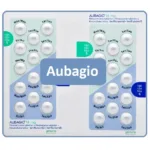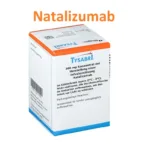Ocrevus is the trade name of Ocrelizumab. It is an FDA-approved drug that was introduced into the US market in 2017. It is marketed by Genetech group, a member of the Roche group of companies.
Its main indication was to be used in Multiple sclerosis who are intolerant or have an inadequate response to 1st line therapy.
Ocrevus (Ocrelizumab) is not indicated in combination with other strong immunomodulating drugs that are used to treat Multiple Sclerosis such as Natalizumab, Tacrolimus, Pimecrolimus, and Cladribine.
Brand Name:
- Ocrelizumab
Pharmacology and MOA of Ocrevus:
Mechanism of Action of Ocrevus (Ocrelizumab MOA):
- It is a humanized monoclonal antibody designed to selectively target CD20, a cell surface antigen present on pre-B and mature B lymphocytes.
- After it binds to the cell surface of B lymphocytes, ocrelizumab results in antibody-dependent cellular cytolysis and complement-mediated lysis.
Absorption:
- Peak plasma concentration: 212 mcg/mL (600 mg); 141 mcg/mL (300 mg).
- AUC: 3510 mcg·mL/day
Distribution:
- Central volume distribution: 2.78 L
- Peripheral volume compartment: 2.68 L/day
- Intercompartment: 0.29 L/day
Elimination:
- Terminal half-life: 26 days
- Clearance 0.17 L/day
- Metabolism: Like all other immunoglobulins, it is metabolized by proteolytic enzymes into smaller peptides which are then used as energy in the body.
| You may also like to read: |
How to Administer Ocrevus (Ocrelizumab):
Before administering Ocrelizumab, make sure the patient is free of all sorts of infections including hepatitis B infection and mycobacterium tuberculosis [Ref].
IV preparation:
The vial should be inspected for particulate matters and should not be used if the solution is discolored or unclear.
- Do not shake the vial.
- It should be diluted with normal saline so the final concentration would be 1.2 mg/mL. 300 mg in 250 ml normal saline or 600 mg in 500 ml normal saline.
- It does not contain any preservatives and it should be used at a single time.
- IV solution should be at room temperature while infusing.
- Infusion reactions should be observed closely one hour after the infusion has been completely administered.
Infection assessment:
- At each time patient should be assessed for active infection.
- If present, the infusion must be delayed till the infection resolves.
Premedication:
- It should be done to reduce the severity of the reaction.
- 100 mg IV methylprednisolone over 30 minutes or an equivalent dose of another steroid.
- Antihistamine can be given IM/IV 60 minutes before each infusion.
- The use of antipyretic might also be considered.
Infusion rate:
Initial 300 mg dose:
First 2 IV infusions:
- Start IV at 30 mL/hr
- Increase by 30 mL/hr q30min
- Maximum rate: 180 mL/hr
- Infusion duration: ≥2.5 hr
Subsequent 600 mg doses may be administered following any of the following two strategies:
Strategy #1 | Strategy #1 |
|
|
In case the dose is missed or delayed:
- It should be administered as soon as possible and should not wait for the next dose.
- Reset dose that subsequent dose should be 6 months after the last dose
- The difference between the two doses should be at least 5 months.
How to Store Ocreuvs (Ocrelizumab)?
Unopened vials:
- Refrigerate at 2-8 centigrade and should not be shaken
- The vials should not be frozen.
Diluted solutions:
- Refrigerated at 2-8°C (36-46°F): Up to 24 hr
- Room temperature up to 25°C (77°F): 8 hr (including infusion time)
- In the event an IV infusion cannot be completed the same day, discard the remaining solution
| You may also like to read: |
Indications and Uses of Ocrervus (Ocrelizumab):
- It is indicated for the treatment of a relapsing or primary progressive form of MS in adults. Ocrevus is the only drug approved for the treatment of primary progressive multiple sclerosis.
- The initial dose is 300 mg intravenous infusion, followed by another 300 mg of dose 2 weeks after.
- Subsequent doses should be given at 6 monthly intervals.
Dosage strength:
- It is available as a 30mg/mL 10mL vial. The vial contains a total of 300 mg dose.
Dosage Modifications:
Dosage modification depends upon the severity of the infusion reaction.
Mild to moderate side effects:
- Reduce the infusion rate to half the rate at the onset of the infusion reaction and maintain the reduced rate for at least 30 min. If tolerated, may increase the rate.
Severe reactions:
- Immediately interrupt the infusion and administer appropriate supportive treatment, as necessary
- Restart infusion once symptoms have been resolved
- When restarting, begin at half of the infusion rate at the time of onset of the infusion reaction. If tolerated, may increase the rate
Life-threatening side effects:
- Discontinue the infusion. Do not repeat the dose
| You may also like to read: |
Things to be kept in mind while using Ocrevus:
HBV screening:
- Perform HBV by ELISA before using this drug.
- It is contraindicated who are confirmed positive for HBsAg.
- For patients who are negative for surface antigen [HBsAg] and positive for HB core antibody [HBcAb+] or are carriers of HBV [HBsAg+], consult liver disease experts before starting and during treatment
Vaccinations:
- Vaccination with live-attenuated or live vaccines is not recommended during treatment and after discontinuation until B-cell repletion
- Administer all immunizations according to immunization guidelines at least 4 weeks prior to initiation for live or live-attenuated vaccines and, whenever possible, at least 2 weeks prior to initiation for non-live vaccines
Immunoglobulins level:
- Quantitative levels should be done, if low, the infectious diseases department should be consulted
| You may also like to read: |
Ocrevus Interactions with other drugs:
Serious interactions can occur with live vaccines and the use of other monoclonal antibodies concomitantly. Always tell your doctor about other diseases you have or if you are taking any other drug.
Side effects of Ocrevus (Ocrelizumab):
- URI (Upper respiratory tract infections)
- Infusion reactions at the site and generalized systemic reactions
- Skin reactions
- Neutropenia
- LRTI (lower respiratory tract infections)
- Dry cough
- Back pain
- Diarrhea
- Peripheral edema
- Peripheral neuropathy
| You may also like to read: |
Warnings:
Do not use Ocrevus if you have:
- Active HBV infection
- History of a life-threatening reaction to Ocrelizumab
You should also monitor for the following while on treatment:
- Monitor neutrophil count as it is associated with significant neutropenia.
- Monitor LFTs (liver function tests)
- Check for reactivation for HBV (hepatitis B virus infection)
- Fulminant fungal infections
- Progressive multifocal leukoencephalopathy (PML)
| You may also like to read: |
Pregnancy:
- No data is available to assess risk in pregnant women
- The drug is a humanized monoclonal antibody of an immunoglobulin G1 subtype and immunoglobulins are known to cross the placental barrier
- However, transient peripheral B-cell depletion and lymphocytopenia have been reported in infants born to mothers exposed to other anti-CD20 antibodies during pregnancy
Lactation:
- Unknown/not studied in breastfeeding women and whether it affects the breastfed baby or not.
Cost:
- A single 10 mL vial costs around USD 600 $
| You may also like to read: |



